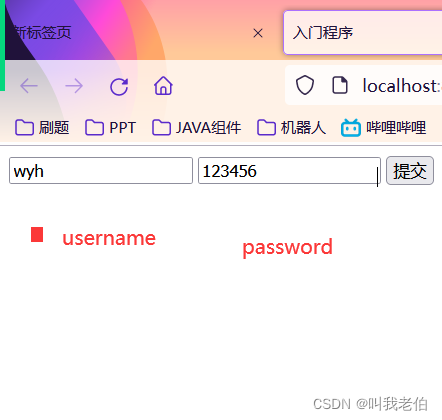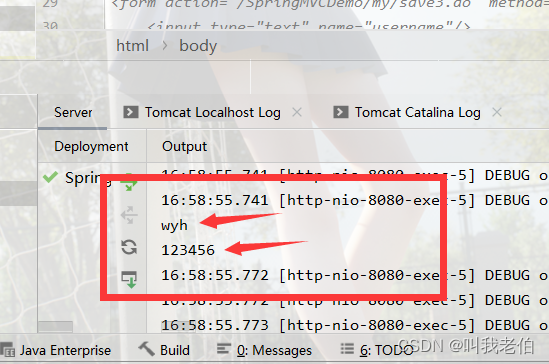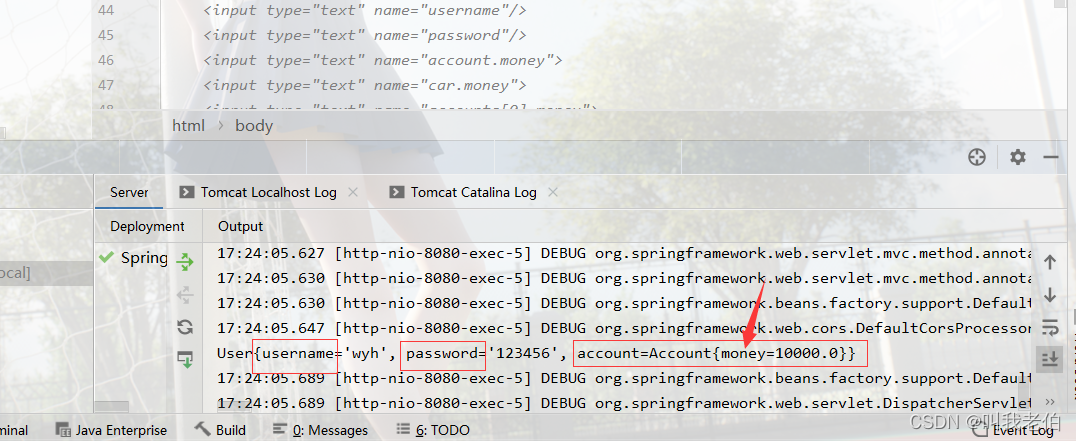获取前端数据
目录
一、简单数据版
1. 配置
先按照搭建SpringMVC框架_我是老伯的博客-CSDN博客搭建SpringMVC框架,然后按照一文学会在idea中Tomcat的配置_我是老伯的博客-CSDN博客配置本地Tomcat。
2. 书写Controlloer层
MyController.java
package com.qcby.Controller;
import com.qcby.entity.User;
import org.springframework.stereotype.Controller;
import org.springframework.web.bind.annotation.RequestMapping;
import org.springframework.web.bind.annotation.RequestMethod;
@Controller
@RequestMapping("my")
public class MyController {
@RequestMapping(path = "/save1.do",method = {RequestMethod.GET})
public static void save1(String username,String password){
System.out.println(username);
System.out.println(password);
}
}2.1?RequestMapping注解
RequestMapping注解的作用是建立请求URL和处理方法之间的对应关系
RequestMapping注解可以作用在方法和类上(相当于servlet当中的@WebServlet)
1. 作用在类上:第一级的访问目录
2. 作用在方法上:第二级的访问目录
3. 细节:路径可以不编写 / 表示应用的根目录开始
????????RequestMapping的属性
????????????????1. path 指定请求路径的url
????????????????2. value value属性和path属性是一样的
????????????????3. mthod 指定该方法的请求方式
3. index.html界面书写
<!DOCTYPE html>
<html lang="en">
<head>
<meta charset="UTF-8">
<title>入门程序</title>
</head>
<body>
<form action="/SpringMVCDemo/my/save1.do" method="get">
<input type="text" name="username"/>
<input type="text" name="password"/>
<input type="submit" value="提交"/>
</form>
</body>
</html>4.? 点击tomcat运行?

?以上是在前端输入的username + password
看我们的idea中输出,这样我们就获取到了前端输入的。

一个简单的获取前端输入数据的功能完成。
?二、数据升级版
当我们需要在前端获取到的数据不在是简简单单String 和 Integer 这种简单类型时,我们该如何处理?也就是如何获取集合类型的数据。
 ?
?
1. 建立实体类entity下的User.java
它下面三个数据,分别生成Get() Set() toString()方法
username;passwordaccount
package com.qcby.entity;
import java.util.List;
public class User {
private String username;
private String password;
private Account account;
public String getUsername() {
return username;
}
public void setUsername(String username) {
this.username = username;
}
public String getPassword() {
return password;
}
public void setPassword(String password) {
this.password = password;
}
public Account getAccount() {
return account;
}
public void setAccount(Account account) {
this.account = account;
}
@Override
public String toString() {
return "User{" +
"username='" + username + '\'' +
", password='" + password + '\'' +
", account=" + account +
'}';
}
}
2. 建立entity下面的Account.java
package com.qcby.entity;
public class Account {
public Double getMoney() {
return money;
}
public void setMoney(Double money) {
this.money = money;
}
private Double money;
@Override
public String toString() {
return "Account{" +
"money=" + money +
'}';
}
}
3.? 编写MyController.java
package com.qcby.Controller;
import com.qcby.entity.User;
import org.springframework.stereotype.Controller;
import org.springframework.web.bind.annotation.RequestMapping;
import org.springframework.web.bind.annotation.RequestMethod;
@Controller
@RequestMapping("my")
public class MyController {
@RequestMapping(value = "/save4",method = {RequestMethod.POST})
public void save4(User user){
System.out.println(user.toString());
}
}
4. index.html界面
<!DOCTYPE html>
<html lang="en">
<head>
<meta charset="UTF-8">
<title>入门程序</title>
</head>
<body>
<form action="/SpringMVCDemo/my/save4.do" method="post">
<input type="text" name="username"/>
<input type="text" name="password"/>
<input type="text" name="account.money">
<!-- <input type="text" name="car.money">-->
<input type="submit" value="提交"/>
</form>
</body>
</html>5. 运行

?运行成功!!

?三、集合数据操作(List<>类型)
1. 实体类中User.java
package com.qcby.entity;
import java.util.List;
public class User {
private String username;
private String password;
private Account account;
private Car car;
List<Account> accounts;
public String getUsername() {
return username;
}
public void setUsername(String username) {
this.username = username;
}
public String getPassword() {
return password;
}
public void setPassword(String password) {
this.password = password;
}
public Account getAccount() {
return account;
}
public void setAccount(Account account) {
this.account = account;
}
public Car getCar() {
return car;
}
public void setCar(Car car) {
this.car = car;
}
public List<Account> getAccounts() {
return accounts;
}
public void setAccounts(List<Account> accounts) {
this.accounts = accounts;
}
@Override
public String toString() {
return "User{" +
"username='" + username + '\'' +
", password='" + password + '\'' +
", account=" + account +
", car=" + car +
", accounts=" + accounts +
'}';
}
}
2. 实体类中Car.java
package com.qcby.entity;
public class Car {
private Double money;
public Double getMoney() {
return money;
}
public void setMoney(Double money) {
this.money = money;
}
@Override
public String toString() {
return "Car{" +
"money=" + money +
'}';
}
}
3. MyController.java不变
(只是改变一下路径@RequestMapping后面的path)
@RequestMapping(value = "/save5",method = {RequestMethod.POST})
public void save5(User user){
System.out.println(user.toString());
}4. index.html界面
<!DOCTYPE html>
<html lang="en">
<head>
<meta charset="UTF-8">
<title>入门程序</title>
</head>
<body>
<form action="/SpringMVCDemo/my/save5.do" method="post">
<input type="text" name="username"/>
<input type="text" name="password"/>
<input type="text" name="account.money">
<input type="text" name="car.money">
<input type="text" name="accounts[0].money">
<input type="text" name="accounts[1].money">
<input type="text" name="accounts[2].money">
<input type="submit" value="提交"/>
</form>
</body>
</html>5. 运行

?
?idea后台成功接收

?
?